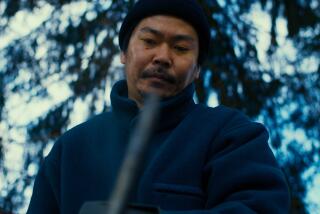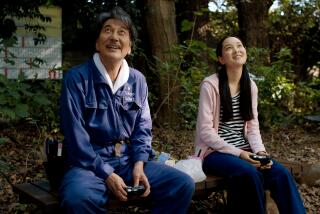‘Kurosawa’ Shows His Life Was the Movies
- Share via
When director Akira Kurosawa died in September 1998, at age 88, he had long been widely regarded as the world’s greatest living filmmaker. As one of his colleagues remarks in Adam Low’s comprehensive and evocative “Kurosawa,” which airs at 9 tonight on KCET-TV, until his innovative 1950 film “Rashomon” won worldwide acclaim, all the West knew about Japan was “earthquakes and kamikaze suicide pilots.”
A period picture, “Rashomon” recounted a bandit’s assault upon a lady traveling through a forest, told from four points of view in a dynamic, highly visual style. Its title, though it literally means “By the Gate,” has entered our lexicon as a word used to describe different points of view of the same thing.
For the record:
12:00 a.m. March 28, 2002 FOR THE RECORD
Los Angeles Times Thursday March 28, 2002 Home Edition Main News Part A Page 2 A2 Desk 1 inches; 23 words Type of Material: Correction
Kurosawa film--A TV review in Wednesday’s Calendar mistakenly referred to Akira Kurosawa’s film “Ran” as a reworking of “Macbeth.” It was a reworking of “King Lear.”
Kurosawa was born in 1910 into an old samurai family, and his father, a military man and later an instructor at a gymnastics institution, was a strict, severe man. Yet Kurosawa would take the rebellion of his older brother, who lived a bohemian lifestyle and worked as a narrator of silent films, a step further by entering the motion picture industry in 1936 as an assistant director. He soon supplemented his meager income by writing scripts.
Kurosawa, who had first studied to be a Western-style painter, got a chance to direct with “Sanshiro Sugata” (1943), a surprisingly mature work about a young judo master seeking enlightenment.
Low has the usual resources of the documentarian of a famous filmmaker at hand: clips from the director’s films, reminiscences from colleagues and family and various archival materials, including substantial illuminating interview footage of Kurosawa. He assembles them in a graceful, evocative manner that captures much of the essence of Kurosawa’s character and personality, his time and place and his enduring impact on filmmaking.
Kurosawa was a proud, determined and disciplined artist who could carry perfectionism to extremes. He suggested looking into his characters to discover what he was like. And of those characters he said, they “try to live honestly and make the most of their lot in life. I believe you must live honestly and develop your abilities to the full.”
Low wisely doesn’t attempt to assess Kurosawa’s more than 30 films in his two-hour documentary but deals with the most significant, such as “Seven Samurai” (1954), an epic saga of a group of wandering samurai who bond with the villagers who have hired them to protect them from bandit attacks; “Yojimbo” (1961), about the adventures of a scruffy samurai for hire, an unsentimental, sometimes dryly comical free spirit; and “Red Beard” (1965), a saga of a pioneering 19th century physician that took two years to make.
The star of these films, who also played the bandit in “Rashomon” and appeared in about half the films Kurosawa made, was Toshiro Mifune, who exuded star charisma. He was also a superb actor, versatile, expressive yet quick and economical in ways that amazed the director.
Winner of a “New Faces” competition held by Toho Studios just after World War II, Mifune was untrained as an actor but quickly caught Kurosawa’s attention. They soon began one of world cinema’s greatest actor-director collaborations, but it came to an untimely and bitter end when Mifune got tired of the seemingly interminable shooting schedules.
Mifune would do many more films but few worthy of his talent before his death in 1997, and Kurosawa would be faced with his aborted involvement with “Tora! Tora! Tora!”, about the attack on Pearl Harbor, and the disappointment of “Dodes’ka-den,” a 1970 Neo-Realist-style drama of shantytown life that would lead to a suicide attempt in September 1971.
Yet with the backing of Francis Ford Coppola and George Lucas and the involvement of 20th Century Fox, Kurosawa came back strong with his large-scale feudal-era battle epic “Kagemusha” (1976) and “Ran” (1985), a glorious reworking of “Macbeth.”
His daughter remarks that, to the end, Kurosawa maintained his passionate interest in films, looking at videos of both his own pictures and those of others.
“Take ‘myself,’” Kurosawa once said, “subtract movies, and the result is zero.”
*
“Kurosawa” can be seen on PBS’ “Great Performances” at 9 tonight on KCET-TV.
More to Read
Only good movies
Get the Indie Focus newsletter, Mark Olsen's weekly guide to the world of cinema.
You may occasionally receive promotional content from the Los Angeles Times.










